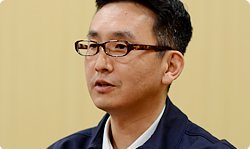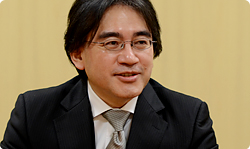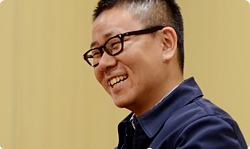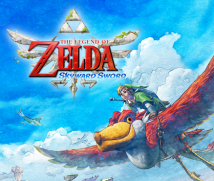3. Twice (or Five Times) the Fun
Did Fujino-san’s logical dungeon satisfy your expectations, Fujibayashi-san?
Yes, even more than I had hoped. His area is the second one, so it’s good that he made it relatively challenging. For the first area, though, I thought someone with the chops of a designer would be able to create something visually comprehensible and asked Kitagawa-san to work on it.
Oh, so that’s how you decide who works on what.
Yes. The third area would test the application of the system the most, so I asked Takemura-san, who had been involved since the original transformation experiments.
Takemura-san, as one with a thorough knowledge of the transformation system, how did you start?
The transformation system is vast in scope.
Earlier, you said you could make a whole game out of it.
That’s right. Take the Timeshift Stones that Link hits. If he could carry one around...
Then only the area around him would transform.
Yes. The various things around him would return to the past or come back to the present, giving rise to lots of new material for gameplay. From early on, even though there were lots of such ideas, we couldn’t fit them in the first and second areas.
Or, if a really cool idea came up while we were working on the first area, we might think, “But I’m not sure this is the right place...”
Well, no matter how cool it is, you can’t ask the players to do anything too difficult in the very first stage.
That’s true. Lots of variations using the transformation system came up right from the start, so we talked about how it would be a waste if we didn’t use them, and that led to me working on a third area.

We had lots of leftover interesting ideas involving the transformation system and had Takemura-san use them to broaden the fun. So the area with the most transformation gameplay may be the third one.
Among the parts I worked on are some time paradox elements between the past and present.
You could say it is the area that makes the most use of the transformation system in addition to being the area most typical of The Legend of Zelda.
The transformation device appears here for the first time in the series, so it will be refreshing for the players, as it was for the developers.
Yes. It was refreshing to make, but actually making the transformations meant that all the data had to be doubled.
Oh, I suppose so. You had to make two sets of data - past and present - for everything.
Aside from Link, we had to make two of everything, from enemies to landforms!
The three of us who worked on the three areas of the desert asked the programmers, sound staff, effects team, and designers to make two of everything, so we had to be certain to get incredibly fun results out of it! (laughs)
Because if you put in twice the effort but it’s only one and a half times the fun...
That’s right. No one would accept it. We opted for only those ideas that made us say, “Oh, well we must do that!” (laughs)
Unless it’s a project that makes the staff say, “We’re doing twice the work, but it’ll be three times, no, five times as fun!” we won’t be able to light a fire in their hearts.

If they went to work saying, “Well, it’s work, so okay...” it wouldn’t turn out well.
But Fujino-san used to be a programmer and Kitagawa-san and Takemura-san were designers, so they understood the difficulties and worked it all out.
Yes. The three of us planners understand the realities of development, so I think the desert stage turned out to be quite satisfying.
That’s an interesting point. There are various ways to make a video game. Depending on company policy, you can become a planner right from the moment you enter the company.
Yes.
But Nintendo doesn’t employ new graduates as planners. We place them in development departments, where they design or program or make music, learning the realities of making video games, before moving on to planning work. This is one characteristic of Nintendo.
Yes. With a system like that, the planners know what kind of confusion their instructions may cause.
With the transformation system that required making two of everything, from enemies to landforms, if you did something wrong, you would inconvenience a large number of people.
That’s right. After I asked them to make two of everything, I couldn’t very well say, “Sorry, but we scrapped them.”
Twice the flavour isn’t enough. It has to be three or five times as good or it isn’t worth the trouble.
That may be why we decided to make three areas.

I see. (laughs) The transformation material was tasty enough to make three!
That’s right.
Aside from the transformation system, how is the desert different from the other stages?
Well, we prepared gameplay using the Wii MotionPlus7 accessory that’s different from the forest and volcano. You can use it in special ways to solve mechanisms in the desert, by twisting things and inserting them. 7Wii MotionPlus: An accessory with a built-in gyro sensor that can detect detailed player movements. It is used by attaching it to the Wii Remote controller. The Wii Remote Plus controller already has this technology built into the controller itself. Either one of them is required in order to play The Legend of Zelda: Skyward Sword.
In other words, you prepared ways of using Wii MotionPlus aside from swinging your sword any direction you want.
That’s right. And we designed enemies for helping clear the stages. Until now, once you defeated enemies, that was the end of them, but on the desert stage, you don’t just use Wii MotionPlus to defeat enemies with your sword, rather, Wii MotionPlus is also employed when you use defeated enemies to solve puzzles.
What do you mean by using enemies?
Defeated enemies don’t just disappear. Specifically, an enemy called Ampilus appears. It sort of looks like a cross between a squilla (a type of mantis shrimp) and an ammonite.
Oh, so that’s why he’s named Ampilus. (laughs) (Editor’s note: in Japanese, the enemy is called Shakomite, which is composed of the terms Shako (a type of mantis shrimp) and Ammonite.)
Yes. (laughs) When we first thought of that enemy, we just had an idea of the kind of gameplay and function we wanted, but no image of how it should look. Then we had a meeting with the designers, and they asked, “Is that a living creature or a machine or what?”
You think of the function first, so the design comes later.
Exactly. We all put our heads together, and in the end the designers polished up Ampilus.
Quite a few enemies that appear in the desert look completely different in the past than in the present. I think the players will be able to get a lot of enjoyment out of just looking around and noticing those things.
